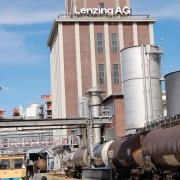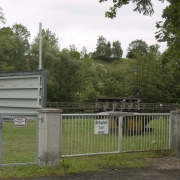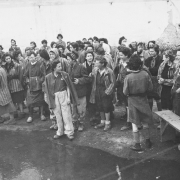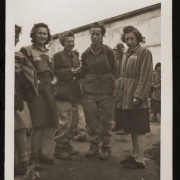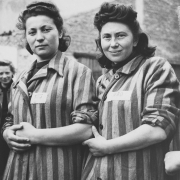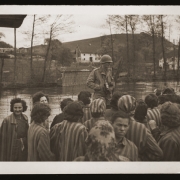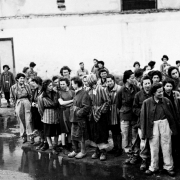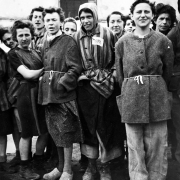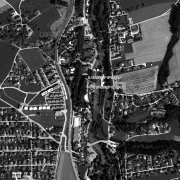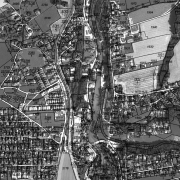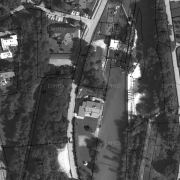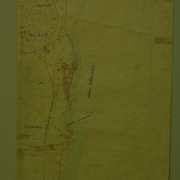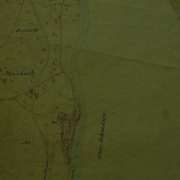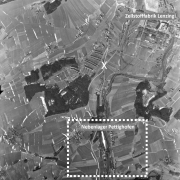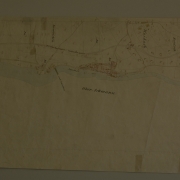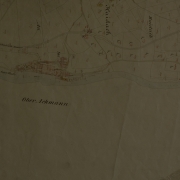Satellite Camp Lenzing
Establishment of the satellite camp
Lenzing Subcamp was established on 30 October 1944, and the first prisoner transport arrived at Lenzing train station from Auschwitz Concentration and Extermination Camp. The prisoners of this transport, however, were not registered in the system of Mauthausen Concentration Camp until 3 November. Before the “Anschluss” (annexation of Austria into Nazi Germany), the production facility was Jewish-owned. The paper factory went up in flames on the day of the invasion and burned down almost completely. The paper and rayon factory was then acquired by the “Thüringische Zellwolle AG”. The new “Zellwolle Lenzing AG” was supposed to be massively expanded. Shortly after the beginning of the war, the first female forced labourers were deported to the large barracks camp surrounding the construction sites. Mauthausen Concentration Camp had been in touch with “Zellwolle Lenzing AG” since 1943 for nutritional experiments on prisoners. The tests involved the tolerance of a protein extract derived from the wastewater of pulp production. In the 1940s, the research department of the German Pulp and Rayon Trust (umbrella organisation of all German pulp and rayon producers) developed a process that allowed for the production of a protein from spent sulphite liquor (which is a by-product in the production of cellulose fibre). By breeding the fungus “Odium lactis”, this protein would form, and a kind of edible spread was made out of it (from “Der Kampf um Lenzing, Teil 1”). This experiment was conducted in the concentration camps of Dachau, Buchenwald, Sachsenhausen, and Mauthausen, but eventually had to be aborted due to massive health problems among the prisoners.
Location
The camp for female prisoners was set up in a closed down paper factory/mill in the neighbourhood of Pettighofen by the Ager river. The daily walk to get to the production facilities took around 45 minutes (approx. 5 kilometres). Along the way, the prisoners also had to pass a railway crossing. In January 1945, a severe accident occurred there, as the guards rushed the prisoners across the tracks and a train crashed into the group. Five women died in the accident. The former paper factory consisted of several small production shops and a walled yard towards the Ager river. The yard was also used for roll calls, which the prisoners had to attend regularly
Prisoners
In total, 577 female prisoners were held at Lenzing Subcamp. They were either transferred over directly from Auschwitz or from Mauthausen. The first transport reached Lenzing on 30 October 1944 (500 women). Further transfers all went via Mauthausen and arrived in Lenzing on 27 January 1945 (54 women) and on 31 January 1945 (23 women) respectively. Despite production having ceased in January 1945 due to a lack of raw materials, the two transfers were still carried out likely because a continuation of the cellulose production was assumed. 577 must be considered a minimum number of prisoners held there. Unlike other subcamps, Lenzing subcamp sent hardly any prisoners back to Mauthausen Stalag. Only two women were brought to Mauthausen and assigned to the large transport to Bergen-Belsen Concentration Camp on 17 March 1945. The large majority of the prisoners at Lenzing Subcamp were from Hungary (323), then Poland (65), the Protectorate of Bohemia and Moravia (58), Germany and Austria (39), and Slovakia (35). 528 of the prisoners were persecuted because of being Jewish; the remaining 49 prisoners were assigned the category “protective custody prisoners". The average age of the detained women at Lenzing Subcamp was 25.6 years; the youngest prisoners were a mere 12 years old, and the oldest was a 49-year old nurse.
Forced labor
The prisoners of Lenzing Subcamp had to work in the rayon factory. The operation was organised in three shifts. The women had to work three weeks straight to get two days off work. The long commute on foot from the camp to the production facility and back only added to the long, exhausting, and unhealthy work. Inside the factory, the women had to work with poisonous chemicals without any protection. As the economic necessity for the war no longer existed as of January 1945, the work in the viscose department, where the raw materials were mixed, was ceased, and the prisoners had to continue to work in the warehouses and workshops. Basically, after the closure of production, the prisoners had to carry out haphazard works on the factory premises and in the area around Lenzing. And despite there no longer being any need for the prisoners to work at the factory, more women were sent from Auschwitz to Lenzing in two transports in late January 1945.
Guarding
SS-Oberscharführer (Senior Squad Leader) Karl Gieseler was camp leader at Lenzing Subcamp. He was supported by 19 other SS soldiers. On 3 November 1944, the first SS officers arrived in Lenzing from Mauthausen, in order to register the 500 female prisoners in the Mauthausen system. As was the case in all other concentration camps with female prisoners, male SS members were responsible for the transport and guard of the camps, while female members of the SS were responsible for internal issues. At Lenzing Subcamp, there were also several Austrians among the female camp wardens. Research revealed several of the names of the SS wardens: Margarete Freinberger (camp leader), Ursula Abeling, Elisabeth Bachner, Margarethe Berger, Hermine Kehrer, Elisabeth König, Maria Künick, Elfriede Monnig, Eleonore Pölsleitner, Antonia Rachbauer. As for the male SS members, for now only their number and the name of the commander are known.
Liberation
Rumours about the nearing end of the war and the imminent liberation emerged quite early at Lenzing Subcamp. Survivor Sándorné Antal said that camp leader Gieseler announced the imminent liberation in an address around Christmas 1944. The guards left Lenzing Subcamp on 4 May 1944. The female wardens tried to go into hiding among the civil population. The first US troops arrived in Lenzing on 5 May 1945. The women remained in their accommodations due to their weakened state and were left to their own devices for several days after the liberation. This suggests that the US soldiers didn't really check on the camp in the old paper factory at first. On 8 May, two male prisoners arrived from Redl-Zipf Subcamp. The US soldiers had requested their help to organise accommodation, food supplies, and medical care. Only 562 women survived until the liberation of the Lenzing Subcamp
Commemoration and remembrance
In 1992, the town of Lenzing erected a memorial stone near the former camp, upon initiative of the Mauthausen Committee Vöcklabruck [1]. The Mauthausen Committee Vöcklabrück organises annual memorial celebrations. The relevant date can be found in the programme for commemoration and liberation ceremonies [2].

